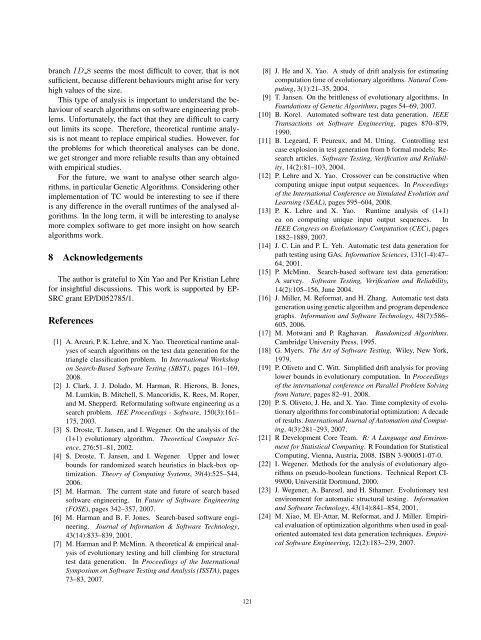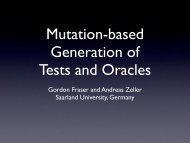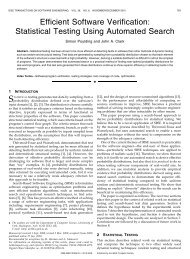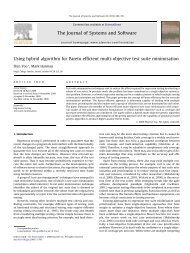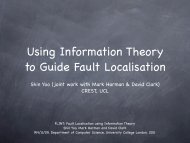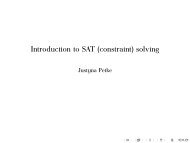Full Theoretical Runtime Analysis of Alternating ... - IEEE Xplore
Full Theoretical Runtime Analysis of Alternating ... - IEEE Xplore
Full Theoretical Runtime Analysis of Alternating ... - IEEE Xplore
You also want an ePaper? Increase the reach of your titles
YUMPU automatically turns print PDFs into web optimized ePapers that Google loves.
anch ID 8 seems the most difficult to cover, that is notsufficient, because different behaviours might arise for veryhigh values <strong>of</strong> the size.This type <strong>of</strong> analysis is important to understand the behaviour<strong>of</strong> search algorithms on s<strong>of</strong>tware engineering problems.Unfortunately, the fact that they are difficult to carryout limits its scope. Therefore, theoretical runtime analysisis not meant to replace empirical studies. However, forthe problems for which theoretical analyses can be done,we get stronger and more reliable results than any obtainedwith empirical studies.For the future, we want to analyse other search algorithms,in particular Genetic Algorithms. Considering otherimplementation <strong>of</strong> TC would be interesting to see if thereis any difference in the overall runtimes <strong>of</strong> the analysed algorithms.In the long term, it will be interesting to analysemore complex s<strong>of</strong>tware to get more insight on how searchalgorithms work.8 AcknowledgementsThe author is grateful to Xin Yao and Per Kristian Lehrefor insightful discussions. This work is supported by EP-SRC grant EP/D052785/1.References[1] A. Arcuri, P. K. Lehre, and X. Yao. <strong>Theoretical</strong> runtime analyses<strong>of</strong> search algorithms on the test data generation for thetriangle classification problem. In International Workshopon Search-Based S<strong>of</strong>tware Testing (SBST), pages 161–169,2008.[2] J. Clark, J. J. Dolado, M. Harman, R. Hierons, B. Jones,M. Lumkin, B. Mitchell, S. Mancoridis, K. Rees, M. Roper,and M. Shepperd. Reformulating s<strong>of</strong>tware engineering as asearch problem. IEE Proceedings - S<strong>of</strong>tware, 150(3):161–175, 2003.[3] S. Droste, T. Jansen, and I. Wegener. On the analysis <strong>of</strong> the(1+1) evolutionary algorithm. <strong>Theoretical</strong> Computer Science,276:51–81, 2002.[4] S. Droste, T. Jansen, and I. Wegener. Upper and lowerbounds for randomized search heuristics in black-box optimization.Theory <strong>of</strong> Computing Systems, 39(4):525–544,2006.[5] M. Harman. The current state and future <strong>of</strong> search baseds<strong>of</strong>tware engineering. In Future <strong>of</strong> S<strong>of</strong>tware Engineering(FOSE), pages 342–357, 2007.[6] M. Harman and B. F. Jones. Search-based s<strong>of</strong>tware engineering.Journal <strong>of</strong> Information & S<strong>of</strong>tware Technology,43(14):833–839, 2001.[7] M. Harman and P. McMinn. A theoretical & empirical analysis<strong>of</strong> evolutionary testing and hill climbing for structuraltest data generation. In Proceedings <strong>of</strong> the InternationalSymposium on S<strong>of</strong>tware Testing and <strong>Analysis</strong> (ISSTA), pages73–83, 2007.[8] J. He and X. Yao. A study <strong>of</strong> drift analysis for estimatingcomputation time <strong>of</strong> evolutionary algorithms. Natural Computing,3(1):21–35, 2004.[9] T. Jansen. On the brittleness <strong>of</strong> evolutionary algorithms. InFoundations <strong>of</strong> Genetic Algorithms, pages 54–69, 2007.[10] B. Korel. Automated s<strong>of</strong>tware test data generation. <strong>IEEE</strong>Transactions on S<strong>of</strong>tware Engineering, pages 870–879,1990.[11] B. Legeard, F. Peureux, and M. Utting. Controlling testcase explosion in test generation from b formal models: Researcharticles. S<strong>of</strong>tware Testing, Verification and Reliability,14(2):81–103, 2004.[12] P. Lehre and X. Yao. Crossover can be constructive whencomputing unique input output sequences. In Proceedings<strong>of</strong> the International Conference on Simulated Evolution andLearning (SEAL), pages 595–604, 2008.[13] P. K. Lehre and X. Yao. <strong>Runtime</strong> analysis <strong>of</strong> (1+1)ea on computing unique input output sequences. In<strong>IEEE</strong> Congress on Evolutionary Computation (CEC), pages1882–1889, 2007.[14] J. C. Lin and P. L. Yeh. Automatic test data generation forpath testing using GAs. Information Sciences, 131(1-4):47–64, 2001.[15] P. McMinn. Search-based s<strong>of</strong>tware test data generation:Asurvey. S<strong>of</strong>tware Testing, Verification and Reliability,14(2):105–156, June 2004.[16] J. Miller, M. Reformat, and H. Zhang. Automatic test datageneration using genetic algorithm and program dependencegraphs. Information and S<strong>of</strong>tware Technology, 48(7):586–605, 2006.[17] M. Motwani and P. Raghavan. Randomized Algorithms.Cambridge University Press, 1995.[18] G. Myers. The Art <strong>of</strong> S<strong>of</strong>tware Testing. Wiley, New York,1979.[19] P. Oliveto and C. Witt. Simplified drift analysis for provinglower bounds in evolutionary computation. In Proceedings<strong>of</strong> the international conference on Parallel Problem Solvingfrom Nature, pages 82–91, 2008.[20] P. S. Oliveto, J. He, and X. Yao. Time complexity <strong>of</strong> evolutionaryalgorithms for combinatorial optimization: A decade<strong>of</strong> results. International Journal <strong>of</strong> Automation and Computing,4(3):281–293, 2007.[21] R Development Core Team. R: A Language and Environmentfor Statistical Computing. R Foundation for StatisticalComputing, Vienna, Austria, 2008. ISBN 3-900051-07-0.[22] I. Wegener. Methods for the analysis <strong>of</strong> evolutionary algorithmson pseudo-boolean functions. Technical Report CI-99/00, Universität Dortmund, 2000.[23] J. Wegener, A. Baresel, and H. Sthamer. Evolutionary testenvironment for automatic structural testing. Informationand S<strong>of</strong>tware Technology, 43(14):841–854, 2001.[24] M. Xiao, M. El-Attar, M. Reformat, and J. Miller. Empiricalevaluation <strong>of</strong> optimization algorithms when used in goalorientedautomated test data generation techniques. EmpiricalS<strong>of</strong>tware Engineering, 12(2):183–239, 2007.121


